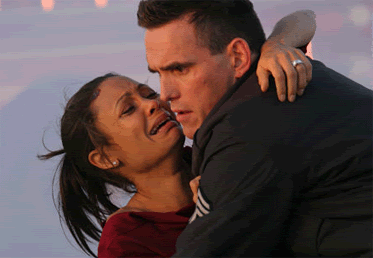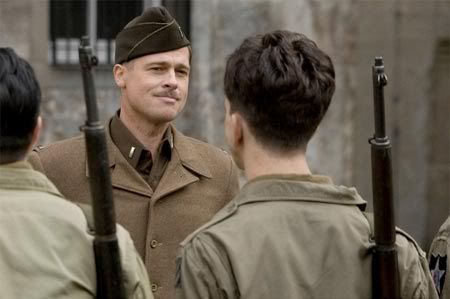This week’s IT CAME FROM NETFLIX! brought to you by a generous donation by Benjamin Axel Jakobsson. Thank you for your support!

[audio:http://www.blueinkalchemy.com/uploads/crash.mp3]
When Hubilub asked me to review Paul Haggis’ Crash from 2005, he did so in the following charming fashion:
It won three Oscars and IT’S FUCKING HORRIBLE!. I hate it so much! It’s so stupid and preachy and…. GOD!
I’d seen the film years ago, and while I didn’t quite remember if it was all that great or not, I did remember feeling uncomfortable watching it, at times. If the film does have a message to shout from its pulpit, it goes something like this: PEOPLE ARE SELFISH PRICKS. It’s a message couched in one racially-charged conversation after another occasionally broken up with music that felt like it came from the secret love child of Enya and Coldplay. It’s got “Oscar bait” written all over it.
I can’t quite bring myself to call it “bad”, though.

Haggis: “Look, Academy! You can tell it’s art by the way it’s shot!”
It’s funny, actually, that I’m watching this right after having watched Pulp Fiction again. Both films involve different plots following an ensemble cast of individuals that weave into and out of each other. In the case of Crash we follow two married couples, two families and two sets of partners who live and work in Los Angeles and deal with issues of bigotry, racism and prejudice. Everybody screws up, everybody lets emotions get the better of them, and most of them learn something. It’s a little snapshot of the human experience, and the film tries very hard to err on the side of honesty about the human condition.
Let’s get the praise out of the way: the film is neither written nor acted badly. From bigger names like Brendan Fraser and Sandra Bullock to surprises like Ludacris, Michael Peña, Shaun Toub and Bahar Soomekh, the delivery of lines and flow of conversations feels natural more often than not. It does feel a bit more scripted than Pulp Fiction‘s dialog, but it’s not bad by any stretch of the imagination. In terms of cinematography, Crash is well-shot, presenting the situations and conversations in an unflinching manner. While this sort of straightforward on-location film-making does keep the audience focused on the meaning of a scene rather than distracting them with superfluous gimmickry, it also makes the heavy-handed nature of the film’s message all the more obvious.

Haggis: “IT’S ART I TELL YOOOOOOOU!”
And when I say ‘heavy-handed’, folks, I mean Crash drops meaning into our laps with all of the subtlety of an anvil dropped from the bomb bay of a B-52. It’s like Paul Haggis took the Avenue Q song “Everybody’s A Little Bit Racist” and re-scored it into a ninety minute operetta. If we were to compare Crash to, say, Schindler’s List, the most apparent difference is that Crash is an entirely fictional work whose characters and conversations merely serve as a vehicle for delivering this rather pedantic message, while Schindler’s List actually downplays the very real horror and tragedy of historical events yet still retains the power of its message without having to be blatant about it. Going in the other direction, take another look at Die Hard with a Vengeance some time. Seriously, the dynamic between John McClaine and Zeus Carver feels a lot more natural and realistic in terms of two men of differing races overcoming their prejudices than a lot of the stuff that happens in Crash. (Also, Vengeance has more gunfights and explosions. And Jeremy Irons.)
Back to Crash. If the film is to be believed, it’s not just that racism is bad and people are selfish pricks. Let’s see, there’s also the fact that just about everybody in LA is thoroughly racist, buying guns in the US is pretty easy for just about anybody even if the salesman is a fat bigoted pervert, and being a racist cop who abuses the position is okay as long as they do their job when its called for. And that’s just some of the unfortunate implications. As much as the script might not be terrible, the plot relies so much on convenience and contrivance that it seems to be talking about predestination and fate as much as it is racism. The pretentiousness of the message coupled with this reliance on the blatantly artificial construction of situations hurls the moviegoer out of the experience with all of the comfort and guidance of someone sitting in the sling of a trebuchet and kicking the release lever thinking that it’s an overly elaborate swing set.

Don can’t get into that War Machine armor fast enough, if you ask me.
I don’t want to give the impression that Crash is a bad movie. There are things in it that go just a bit too far and take away from the overall experience. The good acting is countered by contrived plot points. The decent conversations are balanced with the message that has all the subtlety of a sledgehammer. The end result is something that is, in my opinion, worth watching once or twice but not really deserving of much praise or attention beyond that, and certainly not Best Picture material.
As a personal aside as I wrap this up, I’ll admit I haven’t seen Brokeback Mountain or Munich, two of the other films up for the coveted golden statue back in 2006. I have, however, seen Good Night and Good Luck. That film is well-written, finely acted, intimately shot and uses a documentary style and a basis on real events to add weight to its message. It doesn’t hit you over the head with what it’s trying to say, either. It’s touching, funny and powerful. That film is Best Picture material. Crash tends to get a bit messy here and there. I’ve see worse messes, to be sure. So I guess Crash does get a recommendation, if you can get past the preachiness and the contrivances and the hammy moments and the laughably mournful score and…
Josh Loomis can’t always make it to the local megaplex, and thus must turn to alternative forms of cinematic entertainment. There might not be overpriced soda pop & over-buttered popcorn, and it’s unclear if this week’s film came in the mail or was delivered via the dark & mysterious tubes of the Internet. Only one thing is certain… IT CAME FROM NETFLIX.
















